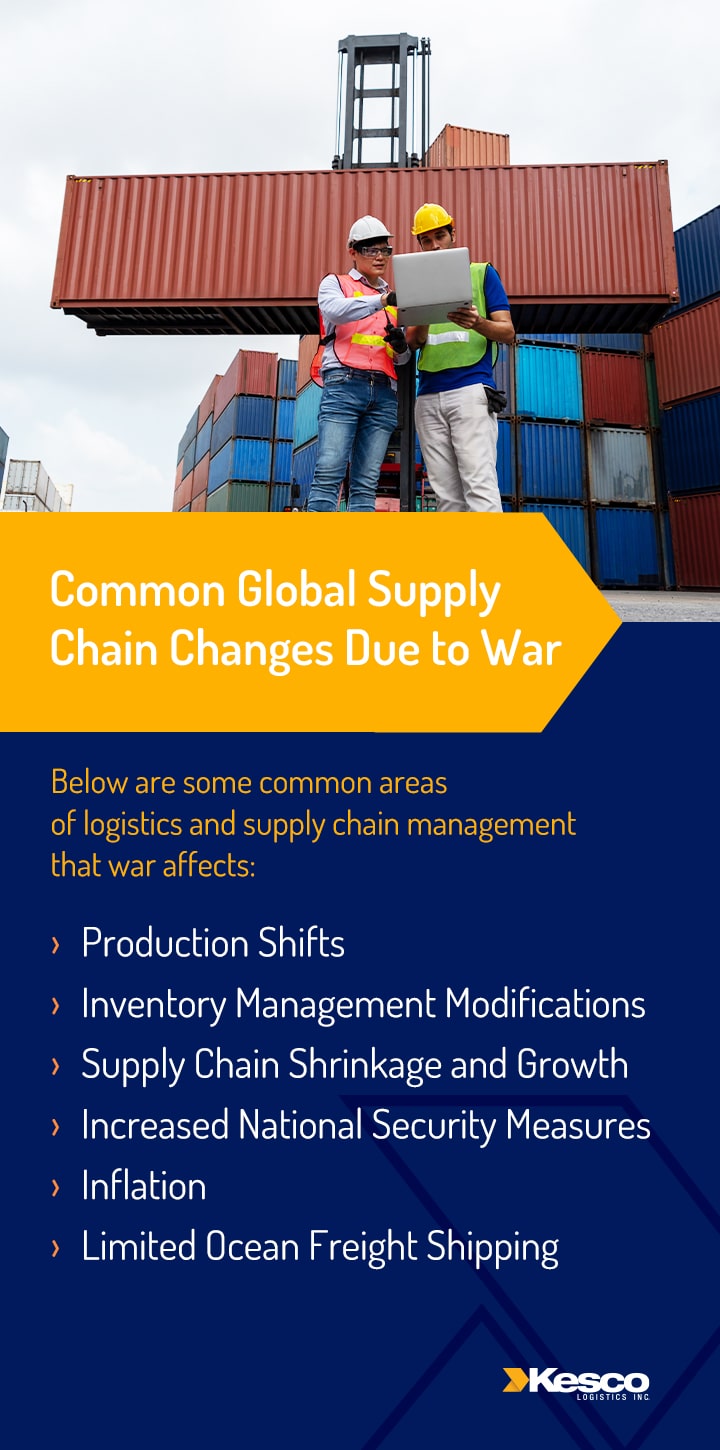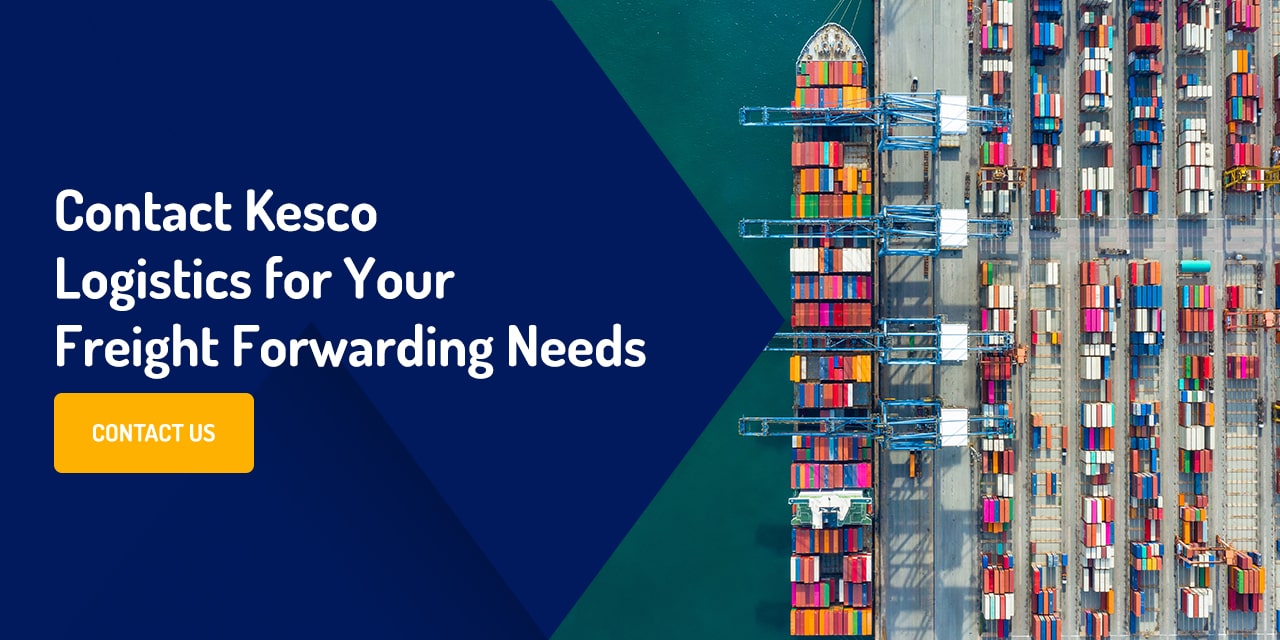How Russia’s Invasion Impacts Supply Chains | Common Global Supply Chain Changes Due to War | How Businesses Can Adjust for Supply Chain Issues | Contact Kesco Logistics for Your Freight Forwarding Needs
The Russian-Ukraine war has been an ongoing conflict since the beginning of 2022, and it has had far-reaching effects that have touched many countries uninvolved in the fighting. One of those affected areas includes the global supply chain, which has seen shipment rerouting, delivery delays and higher transportation costs. War’s effect on global logistics is often tremendous, but exactly how does it change things for businesses and their suppliers?
Below, learn more about how supply chains are faring amongst the conflict and how previous wars have affected the global supply chain. With past knowledge of how war disrupts global supply chains, it may be easier to navigate the ongoing conflict and know what to expect for your operations.
How Russia’s Invasion Impacts Supply Chains
With many of Ukraine’s seaports blocked and production plants closed because of the ongoing conflict, it will likely be a while before supply chains can right themselves again.
Ukraine supplies many commodities and raw materials that can negatively impact manufacturing efforts with exports halted — for example, neon gas, platinum and palladium. These materials are essential for semiconductor microchip production. Two Ukrainian companies that produce half the globe’s supply of semiconductor neon have been hit by the conflict, requiring semiconductor manufacturers to pivot by securing existing supplies and lifting tariffs.
Both Ukraine and Russia export metals like nickel, iron and copper. Copper is a staple material in electronics, while nickel is often used in electric vehicle batteries. Ongoing conflict spells dramatic price hikes for these materials, with London nickel prices rising 30% in March. Those soaring prices will eventually trickle down to consumers who buy consumer goods like copper cables, car batteries and more.
Ukraine also has a significant hand in agricultural production, supplying substantial amounts of rye, corn, barley and wheat that the European Union, Africa and the Middle East depend on. Ukraine even displaced the United States as the leading corn supplier for China in 2021, marking just how expansive the country’s reach is concerning grain products.
A halt in exports of these grains could cause breakbulk and dry bulk shipping rates to become unpredictable by the summer of 2022. Bulk freight rates are already rising due to the lack of available vessels and the longer distances ships must travel, which could further increase food prices.

Sanctions on Russia
Along with Ukraine, Russia is also a major exporter of minerals and agricultural products such as wheat, barley and corn, meaning logistics disruptions in this nation can have the same far-reaching effects as halted exports from Ukraine. This issue is particularly prominent given the sanctions that have been imposed on Russia by various countries. For example, the U.S. has imposed full sanctions on Russia’s most prominent financial institutions — Sberbank and Alfa-Bank — as well as Russian state-owned enterprises like the United Shipbuilding Corporation.
Recent sanctions have encouraged companies in the shipping industry, including large global container shipping and freight forwarder lines, to stop all business with Russian entities, even when trade is still legal. These actions are likely to set a precedent for moral sanctions in the future, changing how the shipping industry chooses to engage with certain countries.
Other shipping impacts caused by these sanctions have included an uptick in deceptive shipping practices by Russian enterprises. Some ships are removing their Russian flags and registering in the Marshall Islands, while others are operating with turned-off tracking systems to evade sanctions.
In addition to the sanctions imposed on Russia, the U.S. is considering imposing sanctions on countries that support Russia, which will affect these nations’ shipping logistics and have consequences for the U.S. For example, these secondary sanctions can result in overcompliance as allies try to stay in alignment with the U.S., creating economic slowdowns across the globe and further exacerbating current supply chain issues.

Common Global Supply Chain Changes Due to War
Though the Russian-Ukraine war is the most recent conflict in everyone’s minds, war, in general, has a drastic effect on shipping logistics. These impacts can take months or years for economies to recover from, especially for developing countries that tend to suffer most from production losses and the rising prices of commodities. War costs the global economy $98.3 billion in production losses, and in 2019 alone, armed conflict amounted to $519 billion for the global economy.
There’s no underestimating the tolls that conflict can take on businesses and their supply chains. Below are some common areas of logistics and supply chain management that war affects:
1. Production Shifts
During World War II, U.S. factories that were initially producing goods like automobiles and home appliances shifted to wartime production to develop weapons and conserve metal for military equipment. Their efforts went toward manufacturing equipment like tanks, guns, aircraft and more, as well as materials like rubber and plastic. Before the U.S. War Production Board was created, 3 million automobiles came off assembly lines in 1941. Throughout the rest of the war, only 139 more vehicles were produced.
Times of crisis may sometimes call for businesses to change their production models and begin making essential supplies and equipment to help ensure public safety and national security.
2. Inventory Management Modifications
During wartime, opposing forces can sabotage the inventories of their enemies’ businesses by damaging and stealing goods, whether by actively breaking into facilities or stealing goods while they’re being transported. These forces may do this to affect the business’s operations, or they may have a dual purpose in procuring needed supplies for survival and continued fighting.
To avoid this issue or decrease the amount of damage done, companies may reduce the amount of work-in-progress inventory and raw materials they keep on hand. This tactic was demonstrated by businesses in Colombia that shrunk their inventories by 9% to 12% during the ongoing civil war between the nation’s government and the Revolutionary Armed Forces of Colombia and the National Liberation Army.
Lowering the inventory-to-assets ratio and increasing the cash-to-assets ratio is beneficial for the company itself, allowing it to strengthen its finances. However, this also causes the enterprise to become unresponsive to last-minute orders, high demands and unpredictable future demands, reducing its competitiveness in the market and slowing overall economic growth.
3. Supply Chain Shrinkage and Growth
Although not a physical war, the trade war between the U.S. and China stifled potential growth and undid existing growth within global value chains, facilitating supply chain shrinkages. This trade war led to significant job loss and detrimental economic impacts on both the U.S. and China. The transportation and manufacturing sectors were just two industries that faced substantial obstacles from tariffs. Many supply chain professionals in the U.S. seek to relocate production out of China or apply for tariff exemptions to avoid high costs, market restrictions and more.
In the opposite sense, there is also a precedent for war facilitating supply chain growth rather than stunting it. World War II ushered in a new era of international trade agreements and global supply chains due to the need to get supplies to soldiers stationed abroad quickly and efficiently. Over the next few decades, more advancements in shipping were made, such as the creation of pallet handling and inventory storage systems to enable quicker supply chain processes.
The supply chain globalization spurred after World War II has been an advantage in many ways. It can also prove to be a detriment in times of distress, like when dealing with pandemic conditions or navigating wartime environments. Companies must make quick adjustments to procure new suppliers and keep business moving, while others may need to temporarily halt operations if they can’t obtain the needed resources.
4. Increased National Security Measures
Supply chain disruptions caused by war and other phenomena can lead to countries coming up short on the very products they need to protect their citizens and maintain national security. These goods can include personal protective equipment, materials that help create military equipment, energy, etc. When one country has the biggest hand in producing a certain product, they can leverage this depending on their relationships with other nations who rely on them for that commodity.
For example, the COVID-19 pandemic led to the realization that 90% of propellant used in the U.S. military is sourced solely from China. This arrangement could prove to be a major security risk if the U.S. were cut off from obtaining this propellant, which prompted U.S. officials to rethink their efforts on how they could obtain this product locally.
5. Inflation
Inflation can occur for various reasons, and conflict is often the cause of heightened prices across numerous industries. World War I and II and the Civil War created inflationary periods in the U.S., with inflation even rising above 20% after World War II ended. Supply shortages, fewer crops and high demand were the main factors in this post-war price hike, along with the removal of most price controls in 1946.
Similarly, prices rose again during the Korean War, with demand for consumer goods heightening as people prepared themselves for shortages. This time, price controls were instated efficiently enough to prevent inflation from rising as drastically as it did during previous wars. The Gulf War presented an inflationary period much like the Korean War in which high prices — specifically for oil — only lasted a short time.
6. Limited Ocean Freight Shipping
Because over 80% of the globe’s merchandise trade volume is transported by sea, it’s expected that conflict can affect naval trade — and vice versa — in numerous ways. Some experts argue that trade and other efforts to integrate international economies can pacify armed conflict due to potential income and supplier loss. Others say that third-party global trade can increase the risk of conflict because countries have more suppliers to choose from and may not suffer as major of an income loss if they target a former trade partner.
Nations with strong naval trading power can avoid the worst effects of disrupted supply chains and the increased shipment insurance expenses associated with conflict. These factors may also encourage countries with strong naval power to incite conflict because they can better manage the consequences, which diminishes the pacifying effect of global trade mentioned earlier. Third-party trade can also become a detriment to countries without robust naval power when stronger enemies set limits on these countries’ ocean trading routes and increase trade costs.

How Businesses Can Adjust for Supply Chain Issues
As more developments unfold regarding the war’s effect on freight forwarding, business owners will want to know how to address all relevant supply chain changes to maintain steady functioning throughout uncertainty. You can manage uncertainties and keep operations flowing during times of crisis by:
- Considering your shipping methods: Your chosen shipping methods will play a significant role in how your company will fare during the ongoing conflict and the time afterward. For example, if ocean shipping is currently moving slower than what you can afford for your customers, consider using air freight or trucking instead, and vice versa. Adjusting and shifting operations if needed will keep your company flexible to maintain efficiency and client satisfaction.
- Hiring a freight forwarder: A freight forwarder can help select the right shipping method and get your products where they need to be. With an honest, customer-focused partner, you’ll always know where your shipment is, and you can choose from a range of options to meet your transportation needs. You can trust that your shipments will be delivered safely and according to regulatory standards.
- Staying updated on the news: The best way to strategize your next move is to be aware of what’s happening around you. Have any of the suppliers or freight forwarders you use been affected by the conflict? What are your best options if you have to change business partners? Look at the current news for developments in the shipping sector that are specific to your vertical. Staying updated can also involve seeing what your competitors are doing to respond to supply chain bottlenecks and adapting these methods to your business model.
Contact Kesco Logistics for Your Freight Forwarding Needs
Though conflicts arise, commodities and materials must still be shipped to keep the world moving steadily. If your business needs a freight forwarder to help manage the uncertainty, turn to Kesco Logistics. We have experience working with industries such as electronics, apparel, contract furniture, specialty food and more to efficiently move products using air freight, ocean freight and trucking.
When you partner with us, you can rest assured you’ll get a trusted logistics company that will adjust to fit your business’s needs and put in the effort to maintain a mutually beneficial working relationship.
Whether you’re just starting in the shipping industry or have years of experience getting your goods where they need to go, we can assist you with freight forwarding for your commodity vertical. Learn more about our freight forwarding services or get in touch to begin working with us.



